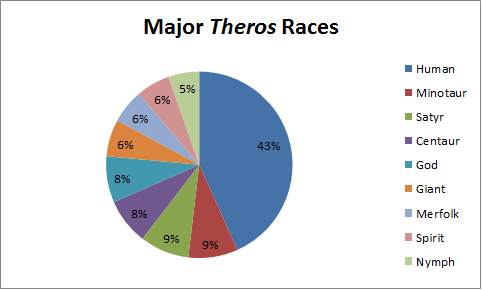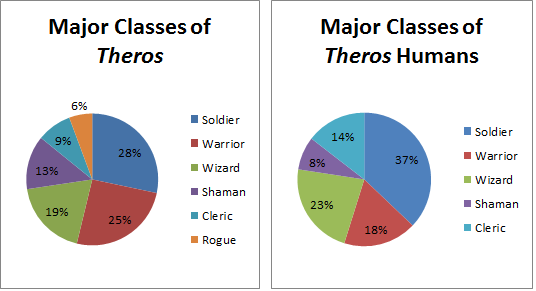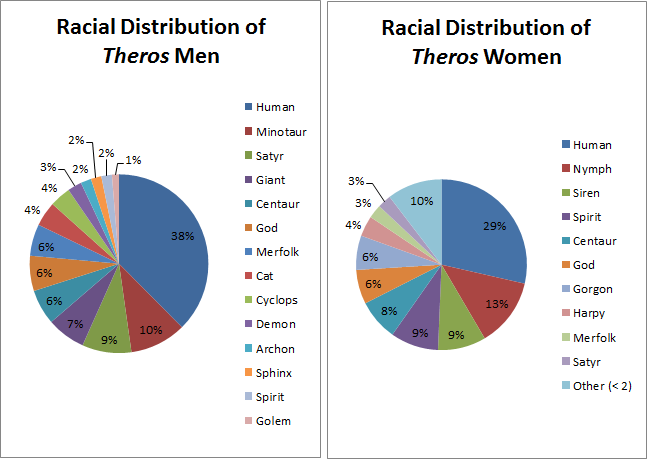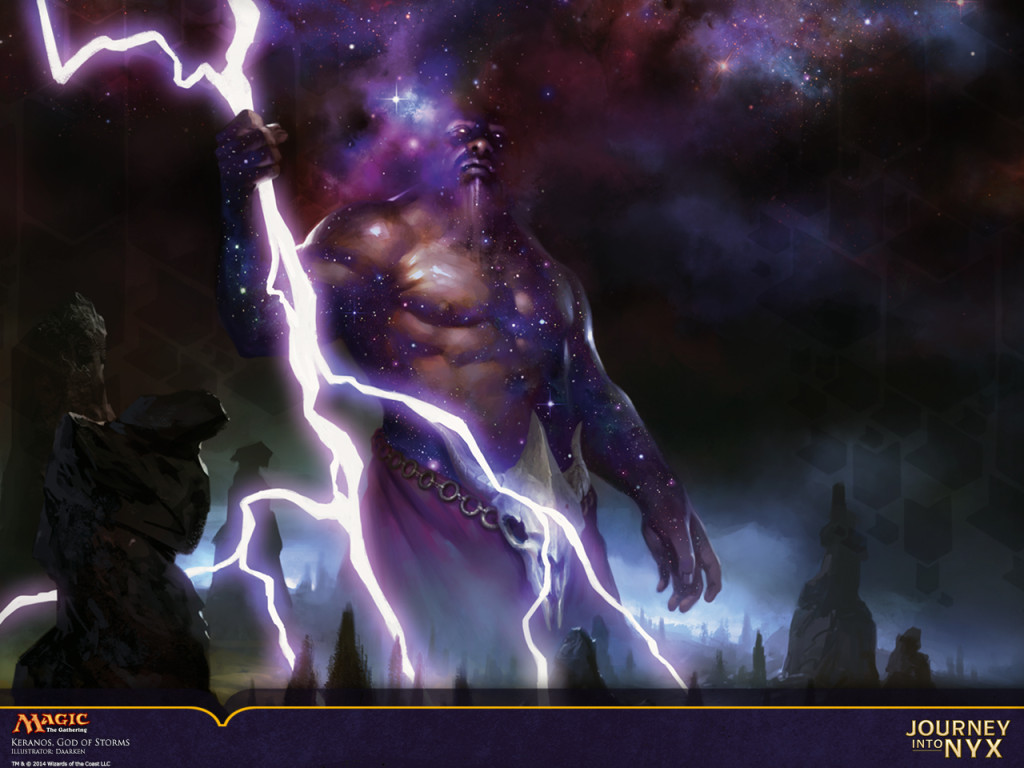Something that I’ve wanted to take a look at for a long time is the break-down of demographics in the worlds created for Magic the Gathering. Creative spends a lot of time developing these worlds and they are presented to us almost exclusively through the cards in the set. This week, I broke down the demographics for all of the creature cards in Theros and learned some interesting things about that world.
Theros Demographics
With the release of Journey into Nyx we have now completed our (first) trip to the world of Theros. As we all know it is a top-down design based on Greek mythology. In that sense, a lot of the themes are very familiar to us. There are stories of great wars, powerful gods, monsters of all shapes and sizes, and so on. However, Wizards also has a lot of freedom to craft worlds according to their own vision. As such they get to set which races exist in the world. The creative team decides how their society is structured. The artists bring that vision to life. In the end, the cards present that world to the players.
So what are the demographics of Theros and why should we be interested in them? Simply put, it is the breakdown of gender, race, and class in Theros. The details are presented in the 323 creature cards spanning all three sets of the block. I am interested in them because the world created by Wizards is not just a reflection of the world of ancient Greece told through its stories. Theros, like all fantasy worlds, is a reflection of our own time and society. As such, we can learn a great deal about ourselves by looking at the demographics of Theros.
Before we begin, I want to make a quick note about the undead. I have decided that, for the purposes of this study, zombies and skeletons do not constitute their own race. They are categorized into the race that they belonged to as members of the living. For example, Agent of Erebos is considered human and Returned Reveler is counted as a Satyr.
The Races of Theros
The creatures of Theros, Born of the Gods, and Journey into Nyx span 59 different races. The vast majority of them, 50 in fact, are represented by less than 10 cards in the entire block. A decent majority, 39 races, are represented by less than 5 cards. Just under half of the races are only represented by a single creature (23). Let’s begin then by focusing on the major races of Theros, which are the ones represented by 10 or more cards. These races constitute over 58% of all creatures in Theros.
Humans are, by far, the largest species presented to us in Theros. This should come to the surprise of nobody. Just like in the Greek mythologies, the human race is the main attraction. The protagonists of many stories are human or half-human. The eternal struggle is always between humans and monsters or humans and gods. Sure, there are plenty of stories of inter-diety conflict but it is always told through the perspective of human suffering. Theros, just like ancient Greece and also as a reflection of our own society, is very focused around the dominant species.
The rest of the major races almost evenly split the remaining 57% of the pie. These are the peripheral species through which the storytellers can shine the spotlight on the sufferings and triumphs of the human race. But, these are humanoid races. Is a conflict between humanity and the minotaurs not just a story of the struggle that humanity has with its own baser, violent tendencies? Satyrs, represented as prominently as the minotaurs of Theros, serve as a personification of the wildest of the extreme excesses of humanity. Is a story about the satyrs any more than a story about the perils of giving in to our own desires in too much excess?
There is a reason that these races, mainly taken from Greek mythology, resonate so strongly with us today. They are still personifications of aspects of our own society. Take the most common conflict represented here, between humanity and its gods. Replace Heliod and Purphoros with any two warring entities in our own world. Now think of the suffering of innocent people living in a war-torn land. The same can be said for any one of these races and it is why they were chosen by Wizards to create the largest demographics within Theros.
Classes of Theros
Although there are 323 creatures across Theros’s three sets, only 121 of them (37%) have a class attributed to them. There are fourteen total classes represented in these cards. They almost exclusively focus on conflict, as evidenced by the fact that the most common class is soldier. Furthermore, only seven of the 59 races of Theros are attributed any class. This is further confirmation of what was previously discussed. The majority of the races, especially the humanoid ones, serve the purpose of presenting a hyperbolic personification of some aspect of humanity.
Below is the breakdown of the major classes. These are found on at least 5 creatures in the entire block. The minor classes, represented by fewer creatures are archer, berserker, adviser, druid, monk, assassin, knight, and scout.
Humanity is still the dominant race and the class structure of the human societies in Theros is presented to us through conflict. As such we get to see the humans who go to battle. It makes little sense for Wizards to make cards representing the more mundane members of society. Politicians, artists, merchants, and so on have very limited, if any, presence in stories of conflict. At its core, Theros is a story about the conflict between humanity and its gods, its monsters, and itself. So the presentation of that story is done through the soldiers, the warriors, and such.
The non-human races that have classes are the ones that have been given a semblance of social structure by Wizards’ creative team. They are, in alphabetical order: cat, centaur, merfolk, minotaur, satyr, and siren. Those races are presented to us in only a dozen or so cards. The fact that some of those cards were given a class means that it was very important for us to have an idea of the societies of those races. Here are some interesting things we can glean from the classes:
- Minotaurs have a very shamanistic society with six shaman cards in Theros. This plays into their purpose as a representation of a deeply emotional aspect of humanity: violence.
- Satyrs also have shamans, three in fact. They also represent an emotional part of the human condition. However, the shamanism they evoke is the spirt of celebration, compared to minotaurs and the spirit of war. The Satyrs also have a druid, which seems to come out of left field a bit but represents their connection to nature as a society.
- Merfolk have five wizards. Centaurs have one but otherwise only humanity has access to that kind of magical ability. This helps reinforce their position in the blue slice of the color-pie. As an aspect of humanity they embody our drive for knowledge and information.
- Centaur society is very similar to humanity in its diversity. It features warrior, wizard, adviser, scout, and archer. Cat society (Leonin really) is also very close to humanity in this way. They feature soldier, monk, warrior, and cleric. The fact that they are close to humanity reflects their role as the “good guys.” We need to be able to relate to them and they represent the nobler aspects of humanity.
Gender Inequality in Theros
The last, but certainly not least, part of the demographics we’re going to cover is gender. For this part we’re essentially looking at the artwork of all 323 creature cards across the block. Each creature was categorized as male, female, both, or neither. The “both” grouping means that both a male and female character feature in the artwork, such as Anax and Cymede. The “neither” grouping means that the character is not humanoid enough for their gender to be discernible from the artwork.
Across the entire block, 48% of creatures were depicted by male characters. Only 23%, less than half as many, are depicted by female characters. Among the humans of Theros the difference is even greater. The ratio of human males to human females is 7:3 while the ratio of nonhuman males to nonhuman females is roughly 2:1. None of this is very good news for the women of Theros or the women of our own modern society.
While the Greek myths largely (almost exclusively) told stories of men, that is not true of modern society. In fact, the main character of Theros is Elspeth, a female planeswalker. However, when given the opportunity to tell the stories of the mythological world in which Elspeth battles Xenagos, Wizards did not keep up with the modern world. Instead, the stories of the struggles of the humans of Theros against their gods, their monsters, and themselves is actually the story of the human men of Theros. The women of Theros are largely forgotten. Even their champion, Elspeth, comes from a different world.
So who are the women of Theros? It turns out that outside of humanity they are mostly used to represent stereotypes that have long been attributed to their gender. Nymphs represent sexual promiscuity. Sirens represent evil seductresses. Gorgons and Harpies embody even worse personality traits. There’s even a hag in there. Meanwhile, the men of Theros are the races we talked about earlier as the ones through which our main stories are told. Minotaurs, satyrs, and centaurs are all well represented by men. In essence, the stories about humanities conflicts involve men. The story that involve women are not about humanity, but are about men in conflict with women.
Wizards built a very exciting world in Theros and did great justice to the Greek mythology that it is drawn from. The stories of this world are really the stories of our own world. They tell of the conflicts we face every day with our own inner demons whether its violent urges, acting out on our desires in excess, or the eternal struggle with near-omnipotent entities we cannot hope to contend with.
Theros tells many stories through the lens of Greek mythology including the modern struggle with gender inequality. It is a world where the men are the heroes even though a woman is raised up to the highest pedestal. The majority of women in Theros are underrepresented and often reinforce traditional stereotypes. Wizards needed to make Theros feel like ancient Greece, and they accomplished this with flying colors. Unfortunately, they also made a world that reflects too well the shortcomings of our modern society, especially the role of women in it.
The Quick Hits
- Last weekend was Nico Nico Douga Choukaigi 3 and Wizards revealed a new card in Conspiracy and From the Vault [Gathering Magic]
- Owen Turtenwald compiled a bunch of Top-X lists [Owen’s a Win]
- John Dale Beety reviews the flavor of Journey into Nyx [StarCityGames]
- Carsten Kotter presents the three most important decks ever built. These are, essentially, the pillars of the Aggro-Control-Combo system we all know and love [StarCityGames]
- Worth Wollpert’s Virtual Party was this past weekend. By now we know how horrendous/awesome that went [MTG Online]
- Magic Judges clarifies a new rules change for us, by which players can no longer use their phones (or any electronic device) at a Competitive and Professional REL [Magic Judges]
- Luis Scott-Vargas interviews the Shadowmage Infiltrator himself, Jon Finkel [Luck, Skill, Victory]
- The Journey into Nyx event deck has been revealed and it looks like a pretty fun Izzet deck [Magic Arcana]
- Cedric Philips reflects back on his first year as content manager for SCG and slyly announces the return of Gerry Thompson to the SCG writing staff [StarCityGames]
- Huey Jensen talks about some of the common traps that developing Magic players fall into [Pitfall Trap]
Wallpaper of the Week
- With Athreos showing up last week as a wallpaper, we should have known it was the start of a five-week cycle of Journey into Nyx god wallpapers. This week’s deity gracing our desktops is Keranos. It’s not a bad piece of art, though a bit dark for my taste. The lightning bolt really stands out against the rest of the image and I suspect that’s the desired effect. The dead minotaur in front of his crotch is also a nice touch. I’m sure Mogis is a big fan.
Grade: B
The Week Ahead
The Grand Prix circuit finally returns this week. After a two-week break for the release of Journey into Nyx, there will be two GP tournaments to watch this weekend! The first comes to us from Warsaw, Poland and will feature the first full Theros block limited GP. Warsaw last hosted a major tournament back in August, which featured Standard as the format. Warsaw’s only other high-level event ever was another Grand Prix way back in 2001.
The second event of the weekend will feature the increasingly-popular Modern format. Minneapolis, Minnesota will be host to this Grand Prix tournament, a possible stop-over for pro players on their way to Atlanta for the Pro Tour in a few weeks. Minneapolis has previously hosted GP events in 2012, 2009, 2005, and 2001.
What We Learned is a weekly feature here at Hipsters of the Coast written by former amateur Magic Player Rich Stein, who came really close to making day two of a Grand Prix on several occasions. Each week we will take a look at the past seven days of major events, big news items, and community happenings so that you can keep up-to-date on all the latest and greatest Magic: the Gathering community news.






